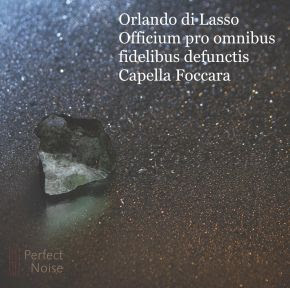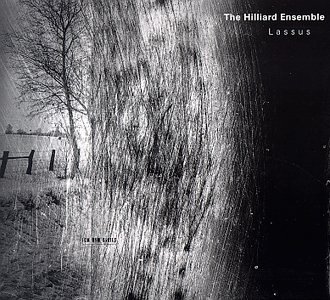Program: #17-33 Air Date: Aug 07, 2017
To listen to this show, you must first LOG IN. If you have already logged in, but you are still seeing this message, please SUBSCRIBE or UPGRADE your subscriber level today.
Fr. Jerome Weber recently reviewed two recordings of the rarely-written-about Requiem settings of Lassus; we will sample from these powerful works. His review is at the bottom of the play list.
I. Orlando di Lasso—Officium pro omnibus fidelibus defunctis (Capella Foccara).Perfect Noise CD PN 1503.

In the manuscript Tonk. Schl. 23, a large choir book from the former Benedictine Abbey St. Ulrich und Afra in Augsburg which is currently housed at the Augsburger Staats- und Stadtbibliothek, musicologist Dr. Tobias Rimek discovered a previously unknown copy of Orlando di Lasso‘s Requiem for four voices [see: Musik in Bayern Bd. 74, 2009. The version found in the Augsburg choir book is not only the oldest, but most certainly the original version of the Requiem, including a setting of the sequence „Dies irae“, which is missing in all of the later transmissions. The original version from Augsburg is a perfect fifth lower than later printed editions of the composition, which puts all four voices of the ensemble into an extremely low register, requiring the following vocal ranges: tenor, baritone, bass und basso profondo. In our rendition (edition: Tobias Rimek) the voices are reinforced with instruments playing colla parte, consistent with performance practice of the period: three sackbuts, bass dulcian and organ magnify the solemn gravity of the composition. Ensemble Capella Foccara, made up of internationally renowned musicians devoted to historically informed performance practice, focusses on lesser-known music from the 16th
to the 18th century, performing primarily works from the regions of Bavaria and Swabia, and from the imperial center Augsburg.
The point of departure for this CD was a convention of the Association for Augsburger Diocesan History, the occasion being the five-hundredth anniversary of the birth of Prince-Bishop Cardinal Otto Truchseß von Waldburg in the preceding year. In order to add an appropriate air of splendour to this commemoration of such an illustrious personality, we reinforced Orlando di Lasso‘s Requiem, originally for four voices, with three sackbuts, bass dulcian and organ. In this magnificent constellation the Augsburg version of the Requiem was recreated on November 21, 2014.
1
Introitus Requiem aeternam
05:48
2
Intonatione del sesto tono
01:17
3
Kyrie eleison
02:40
4
Graduale Si ambulem
05:54
5
Sequenz Dies irae
10:50
6
Quemadmodum desiderat
01:25
7
Offertorium Domine Jesu Christe
04:51
8
Sanctus / Benedictus
03:51
9
Andrea Gabrieli Toccata del decimo tono tono
02:27
10
Agnus Dei
02:34
11
Communio Lux aeterna
02:44
II. Orlando de Lassus: Requiem a 5 (Choir of Girton College, Cambridge/Historic Brass of the Guildhall, London/Gareth Wilson) Toccata Classics CDTOCC 0397.

Lassus’ five-part setting of the Requiem is rarely heard; here it is recorded with brass for the first time, the somber colors of the sackbuts further darkening the tone. Interweaving a number of motets, some also receiving first recordings, and a madrigal on death by one of Lassus’ contemporaries in an organ transcription, this innovative recording takes the listener on a spiritual journey, through the darkness of bereavement to the elevation of the Christian soul after death. Girton College Chapel Choir is an international-prize-winning choir of around 28 members, which has grown in prominence over the last ten years, due to its impressive musical standards, regular recordings, and ambitious, exciting touring schedule. One of the main attractions to students is the combination of low time commitment and high musical standards. During Full Term, the Choir’s principal function is to sing the liturgy in Girton’s Chapel. This includes Choral Evensong every Sunday, and Compline (a beautiful, meditative evening service) on alternate Tuesdays.
Tristis est Anima mea
Requiem a 5
Peccata me domine
Fratres sobrii estote
Exaudi Domine
Adoramus te Christe
Margot, labourez les vignes
Levavi oculos meus
III. The Hilliard Ensemble: Lassus (ECM 1658).

Of the more than 2000 works written by the Franco-Flemsih composer Orlande de Lassus (1532-1594), this benchmark recording by the Hilliard Ensemble encompasses two of his most significant. The plainchant that opens our hearts to the Missa Pro Defunctis provides a level foundation from which to rise slowly into vocal awareness. Like all great polyphonists, Lassus treats the word as flesh, stretching it over the skeleton of a life animated by divine breath. Yet within the godly body beats a heart of silence, and within that silence thrives the core faith through which this music is “visibly” recirculated. It proceeds from, and is written in honor of, the same font. Throughout every moment of the Mass’s conception, we are draped in a veil of obscurity, so that by the Agnus Dei we have shielded ourselves enough to handle a glimpse at the face of our Creator. The closing plainchant not only completes the circle, but spins it like a coin that never stops.
The Prophetiae Sibyllarum is Lassus’s ode to chromaticism, and introduces a unique set of textual and tonal colors that he would never visit again. Unexpected harmonic shifts draw straight lines amid a field of curves. At its densest moments, the Prophecies reach the profundity of Gesualdo, as in the inescapably gorgeous Sybilla Phrygia. These are decidedly secular pieces, constructed as they are around Pagan-influenced texts. Never content in staying in one territory for too long, they are constantly shifting between moods and colors, so that by the end one is left with a fractal of musical effect.
It seems that every new Hilliard Ensemble recording outdoes the last, and this is certainly no exception. Gordon Jones truly stands out here, as he brings a distinct airiness to his lines. The interplay between him and Rogers Covey-Crump in the Graduale of the Mass is astonishing, while David James shines through every turn of the Prophetiae. The music of Lassus would be a puzzle, were it not for the solutions etched upon its surface, as if it were glass and one need only turn it to catch the light the right way to see those inscriptions glowing in a litany of scars across the visage of time. Its meanings are the Alpha and Omega of creation, and duly so for the music created in their name.
Lassus
Missa Pro Defunctis
1 Resposurium: Memento Mei Deus 1:47
2 Introitus 6:12
3 Kyrie 3:19
4 Graduale 5:02
5 Offertorium 5:36
6 Sanctus And Benedictus 4:31
7 Agnus Dei 3:04
8 Communio 3:23
9 Antiphona: In Paradisum 1:25
Prophetiae Sibyllarum
10 Carmina Chromatico 1:35
11 Sibylla Persica 2:32
12 Sibylla Lybica 2:41
13 Sibylla Delphica 2:15
14 Sibylla Cimmeria 2:16
15 Sibylla Samia 1:54
16 Sibylla Cumana 2:15
17 Sibylla Hellespontiaca 2:07
18 Sibylla Phrygia 1:54
19 Sibylla Europaea 2:14
20 Sibylla Tiburtina 2:11
21 Sibylla Erythraea 2:25
22 Sibylla Agrippa 2:24
====================================================================================================================================================================================================================================================================================================================
Not much is written about the Requiems of Orlandus Lassus. I remember when the Schwann and other national catalogs totally confused the only two that had been recorded. Those two works were a four-voice setting published in 1578 and a five-voice setting found in a 1580 manuscript (Munich, BSB 2750) and published in 1589. The five-voice setting heard on the first record has been recorded by Hans Grischkat on a Vox mono LP and by Bruno Turner on Deutsche Harmonia Mundi (stereo LP; CD in Fanfare 14:1), so it’s high time for the first new version of the CD era. It’s good to report that this is a splendid performance by an adult mixed choir.
There is a caveat, however, for the inclusion of a brass ensemble here goes back to a performance of this Requiem at Girton College by these combined forces. This event led to the recording, for, as the notes assert, “although Lassus’ four-voice Requiem has been widely performed and recorded, his five-voice setting has received relatively little attention, and has never been recorded with brass accompaniment.” This reflects a glance at recent record catalogs, for the opposite was the case until 1981, when this work was first recorded. Additionally, there are two reasons why brass was an unlikely accompaniment for a Requiem: the traditional ban on instruments for funerals, and the emphasis in the Munich of Lassus’s time on enforcing the Counter-Reformation acts of the Council of Trent.
The three instrumental performances of motets are smoothly rendered, while oddly enough the motets Fratres, sobrii estote and Adoramus te are given lovely unaccompanied performances. Only the closing motet brings the choir and brass together again. Two secular organ pieces are inserted into the program, as happened more often than the clerical bans could prevent. That leaves Turner’s unaccompanied version with a small adult male vocal ensemble as the preferred version of the Requiem and the only other one on CD (the instrumental forces listed in Turner’s booklet are used only in three of the four motets that fill out the disc). If you prefer instruments with choir, you will thoroughly enjoy this.
The four-voice setting heard on the other record has been recorded by Mark Brown (7:2; CD in 10:5 and 14:1), the Hilliard Ensemble (22:3), and Stephen Cleobury (30:2). It is called here an Office of the Dead, a poor choice of name since it is no more than the Requiem Mass, unlike Victoria’s similarly titled work, which includes the funeral rites. It is described as the original 1575 version of the familiar four-voice work published in 1578, with the Dies irae, missing from all later sources, included from the original manuscript. This source, found in the Augsburg State Library, was first described in 2009 by Tobias Rimek, who prepared the edition used here. The Capella Foccara, male voices one to a part, sings a half-tone lower than Mark Brown’s similar group, a full tone lower than the similar Hilliard Ensemble, and a tone and a half lower than Stephen Cleobury’s adult male vocal ensemble (members of King’s College Choir, Cambridge). Unlike all three, they add brass instruments and organ abundantly, though the manuscript shows no such provision, not only accompanying but filling in between and adding a couple of Gabrieli pieces. Brown alone inserts the chant Dies irae where this ensemble sings the Lassus setting, an alternatim setting of the even verses. Foccara sings the entire sequence, including an 18th strophe, Ne me perdas sed regnare, that was added to the 13th-century sequence in southern German sources in the 15th century. It serves to fill out the melodic pattern of three double strophes repeated three times (hence the need for an 18th strophe before Lacrimosa).
While the Dies irae is a valuable addition to our Lassus recordings, the low tessitura is derived from the manuscript source, which is written a fifth lower than the printed edition, but the overpowering brass were added simply to make the first modern performance (in Augsburg in 2014) more solemn. Those are not the only disadvantages of this disc. The playing time is simply unacceptable for a newly recorded program. The Hilliards and Cleobury added a substantial filler, while Brown, planned for LP and issued on a short CD, was soon reissued in a more generous two-disc box. I prefer the Hilliard Ensemble on balance, while Brown’s version in the boxed set is a bargain. J. F. Weber
Composer Info
Orlande de Lassus (1532-1594)
CD Info
CD PN 1503, CDTOCC 0397, ECM 1658